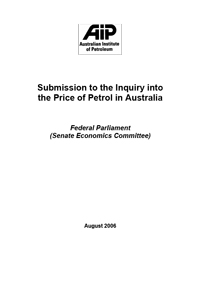Australian fuel prices closely follow Singapore prices
The Australian Institute of Petroleum (AIP) has recently lodged a comprehensive submission to the Senate Committee Inquiry into the price of petrol in Australia. This submission has been prepared to improve community understanding about petrol pricing in Australia and the international and domestic factors impacting on the level of petrol prices and on their movement over time.
The Executive Director of AIP, Dr John Tilley said that analysis by AIP in its submission, together with that from other authorities like the ACCC, clearly shows a very close relationship between international fuel prices and the wholesale price of fuel in Australia.
“The relationship between Singapore prices and Australian Terminal Gate Prices (TGPs) can be easily identified and, contrary to the views of some commentators, major oil companies are not “price gouging” or “profiteering”. In recent weeks, the fall in Singapore petrol prices has clearly flowed through to Australian TGPs. The speed with which changes in TGPs flow through to pump prices will be determined by a range of factors including local area competition.” Dr Tilley said.
Dr Tilley said, “there are a number of fundamental mistakes which continue to be made by some alarmist commentators, despite the facts being readily available.”
First, TGPs are calculated on the basis of what it would cost to import petroleum products into Australia. This is the same basic methodology used in Australia when prices were regulated by the Australian Government prior to 1998.
- TGPs include freight and insurance, a quality premium for Australian fuel standards, exchange rate adjustments, local wharfage and terminal costs, net tax (excise and GST less any state subsidy) and, to the extent competitively possible, allowance for a wholesale marketing margin.
- In recent years, there have been increases in both shipping/transport freight rates and in fuel quality premia (reflecting the introduction of tighter fuel quality standards in Australia).
”The Australian community and the environment have been the beneficiaries of substantial improvements in national fuel quality standards for both petrol and diesel, which help reduce air pollution from vehicles.” Dr Tilley said.
Second, there is a short time lag of 1-2 weeks between changes in Singapore prices and changes in Australian wholesale prices and this time lag occurs whether prices are going up or down.
- This lag reflects the well established but different TGP pricing methodologies used by fuel wholesalers in Australia.
- A typical TGP formula would include a rolling average of Singapore spot petrol prices (MOPS95) and the other costs noted above.
Third, refiner margins are not set by the major oil companies. They are simply the difference between international crude oil and international product prices. These prices are determined by the market and reflect the prevailing supply/demand conditions for crude oil and products.
- Information on these international benchmark indicators of crude oil (Tapis) and petrol (MOPS95) are widely published on a daily basis.
- The difference between the price of Tapis crude oil and petrol from Singapore refineries is the commonly quoted gross ‘Singapore petrol refiner margin’.
Fourth, refiner margins are not profits accruing to major oil companies.
- The gross Singapore petrol refiner margin has averaged around 3-4 cents per litre during the last two years.
- All refiner costs (apart from crude oil) need to be deducted from the gross margin to determine profits – for example, costs like refinery operations, crude oil and product storage, local wharfage and terminal costs etc.
- In the past week, the gross Singapore petrol refiner margin has been negligible.
Dr Tilley said, “a more careful and accurate analysis, based on these four facts, would show that TGPs have remained closely in line with Singapore prices - particularly once the price effects of tougher fuel standards and higher freight rates were taken into account and the effect of the price lag which occurs whether prices are going up or down.”
“It is well known that the international price of petrol plus Australian taxes (net) represents almost the entire wholesale price of petrol. Once fuel leaves the refinery or the terminal gate, however, retail prices may vary across metropolitan and regional areas, reflecting local area factors and competition. The major oil companies only set retail prices at a limited number (about 5%) of service stations across Australia.” Dr Tilley said.
AIP strongly advocates a competitive market for fuel and publishes daily pricing information and data on its website to support this.
For more detail on these facts, see the AIP submission to the Senate Committee Inquiry at: AIP Submission to the Senate Petrol Price Inquiry (PDF)
Media Contact:
Dr John Tilley
Executive Director, AIP
(02) 6247 3044
Background
AIP was established in 1976 as a non-profit making industry association.
AIP’s mission is to promote and assist in the development of a sustainable, internationally competitive petroleum products industry, operating efficiently, economically and safely, and in harmony with the environment and community standards.
AIP member companies play various roles in each segment of the fuel supply chain. They include the four major (refiner/marketer) oil companies who operate all of the petroleum refineries in Australia and handle a large proportion of the wholesale fuel market. AIP member companies directly operate and control only a relatively limited part of the retail market.
